How to Increase Website Traffic in 2023 without spending $1000s
Are you trying to increase website traffic?
So your website is ready, you've got a sales funnel built and ready to convert visitors into leads and customers, and now want to generate a steady stream of visitors to fill the top of your funnel.
We will cover many website traffic strategies in this article that if implemented, will help you bring traffic to your website. The quest for more traffic is usually never-ending, business owners/site owners always want more readers or more customers so more website traffic is always seen a the solution.
First, we will look at what traffic is, the quality, and the types of traffic.
What is website traffic?
Website traffic refers to the flow of visitors to your website. This usually varies over time and is measured in visitors per day and many SEO tools (such as SEMrush, Ahrefs, and MOZ) report visitors per month.

Traffic Quality and Why it Matters
Why do we care about website traffic quality?
It's important to know how valuable a specific piece of traffic is and where it comes from because the majority of your website visitors will not convert.
We want high-quality relevant website traffic that will turn into leads and customers, so we can close more sales.
We should care more about the quality of the traffic than the volume.
Here's an example, there's a restaurant that sells gourmet burgers and they want more sales.
If I create a Google Ads campaign that says "Free Burgers", I'll get lots of traffic from people wanting the free burger and if they don't see an offer for free burgers on the landing page, they will leave unhappy. I'll have gotten lots of traffic, but all looking for a freebie.
This is low value, low quality traffic.
On the other hand, if I create an Ad campaign that says "Best Gourmet Burger for 100miles", the traffic generated will be much less, but those that do click through to the landing page will be higher value, they are looking for what the restaurant specializes in.
This is relevant traffic of much higher value.
We can use this traffic to grow our restaurant's client base.
This is the type of website traffic we should strive to generate.
Measuring Website Traffic - the best tools
So where are we starting from? How much traffic are you getting today? Which day of the week, or week of the month, or which week of the year gets the most traffic and why?
We need a way to find the information that can help answer these questions and that will show our progress over time.
There are several tools on the market that can measure and help us analyze traffic to our site. Google provides free tools just for this purpose and as such, they are the first option for many.
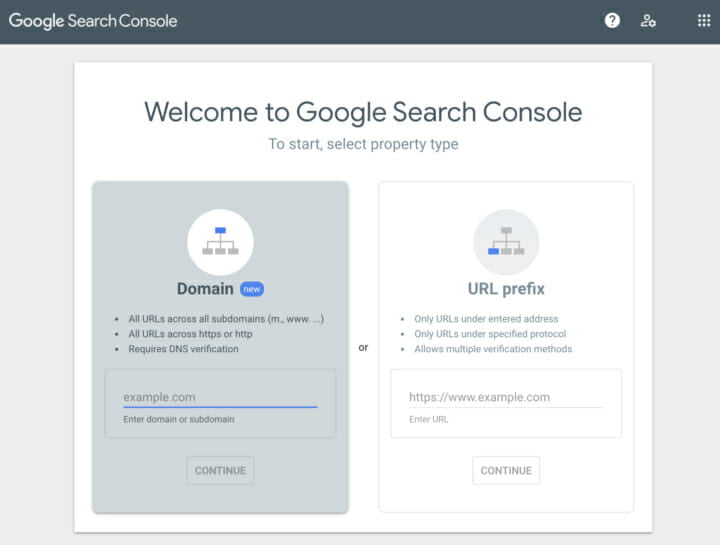
Google Search Console and Google Analytics work together to provide a good set of data for your analysis. Google Tag Manager is a great tool (and another free one, Google is very kind providing so many great free tools) that allows you to deploy the scripts you need to install on your website to enable data collection.
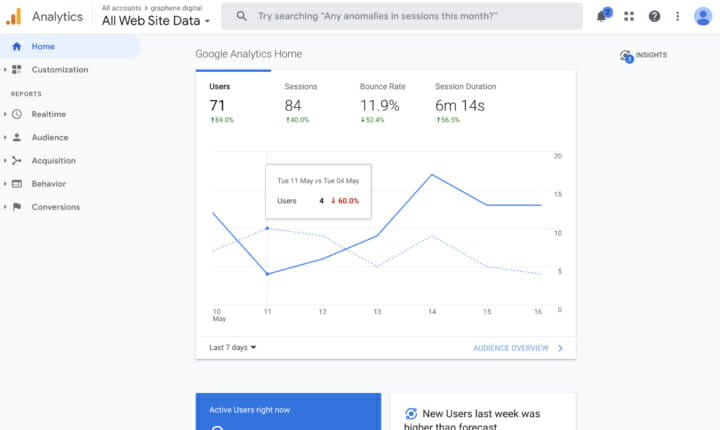
Google Search Console integrates into Google Analytics (GA) providing further information such as search queries, referral sources, and platform types used.
Within GA, you should also configure Conversion Tracking. This allows GA to measure the effectiveness of each campaign and each website traffic source.
So as you create and run your traffic generation campaigns, remember to use the measurement tools to check performance and progress towards your overall goals.
Website Traffic sources - where traffic comes from, categories
If you head into GA and navigate to
Reports -> Acquisition -> Overview
You'll see a breakdown of the website traffic by 'Channel' or source, you'll see a nice pie chart:
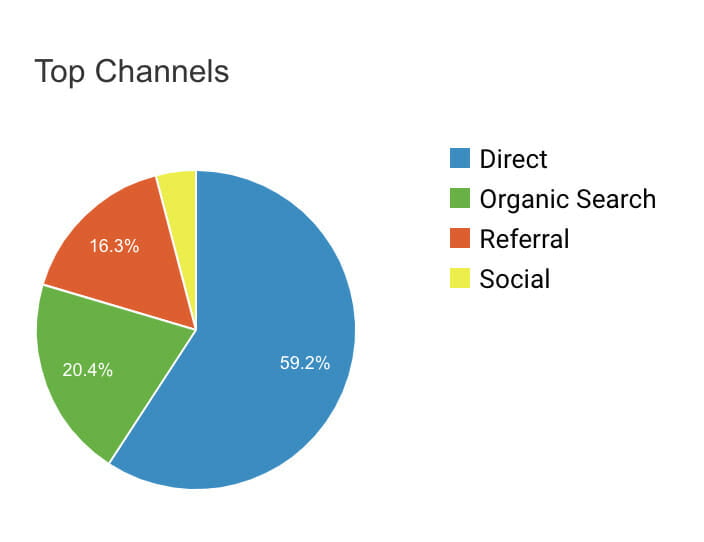
We have:
- Direct traffic - this is where someone clicked on a link to your site in an email (that wasn't tracked), or when a visitor types your URL into their browser
- Organic Search - a visitor found you using a search engine - otherwise known as organic traffic, or search traffic
- Referral traffic - the visitor clicked on a link to your site from another website
- Social - our visit came from a facebook or other social networks, they click a link in a post (or other content in the network) that lead to your site
This breakdown gives you some information about the source of your visits, but it's not that useful. There are other reports that give more detail. A favorite is the Source/Medium report
Reports -> Acquisition -> All Traffic -> Source/Medium
Here's the kind of information you'll get:
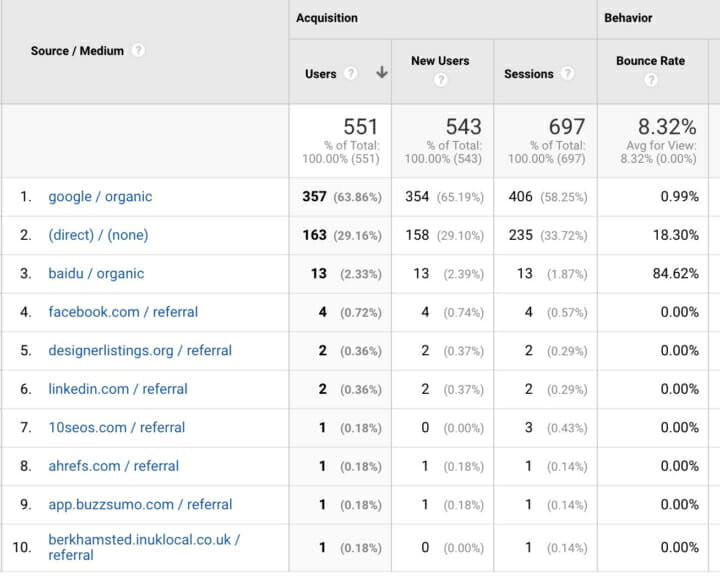
This report gives a much more detailed breakdown of where your website traffic originated and if you take a closer look, you'll get insights into their behavior on your site.
If you want even further detail about your website traffic sources and the effectiveness of your traffic generating campaigns you'll want to implement UTM tracking.
UTM tracking can show you the particular Facebook ads or the particular email in an email sequence, you can get a very granular breakdown.
First things First (okay, not quite, Second)
Before we look at how to drive traffic to your site we need to ensure that the time and money spent driving that traffic isn't wasted.
Imagine spending 40 hours crafting a killer google ads campaign that engages 1000's of your ideal clients and drives them to your website.
Then you find out that they couldn't buy what you offered because there was an issue with the landing page. Nobody converts (buys) and all that effort was wasted.
It's much better to ensure that your website is ready for traffic, that it converts visitors into leads, and that more leads will turn into more customers.
UI/UX Usability
From the UI/UX viewpoint, you can use a service that will do some testing for you.

Usability Hub provides a service where you can get your pages in front of real live people, and you can test their reactions to your messages/pages.
You'll want to refine your content, perform A/B tests of each part of the sales funnel, make changes and re-test.
When you have tweaked your website, your offer, and your messages to get a conversion rate that makes sense (is around your industry standard) then you are ready for traffic.
Ooops ... pause.
On-pageSearch Engine Optimization (SEO)
You will want to ensure that your on-page Search Engine Optimization (SEO) has been completed. Your web designer or digital marketing team should have sorted this out for you, but you want to know that it's complete.
You want your website to make your potential customers happy, but it also needs to make the search engines happy.
Do you have structured data (so you can get rich site snippets)?
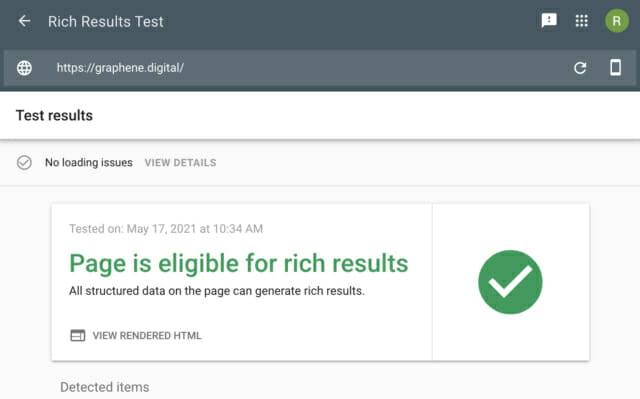
Have your blog posts followed a strategy for internal links?
Are your pages and posts optimized each around a target keyword? (Someone will need to have performed keyword research, looked at high search volume keywords, medium and low, checked keyword difficulty, etc to ensure this could be done). Do they have the right page titles? Do they target an appropriate selection of long-tail keywords?
The 3 Types of Website Traffic
When it comes to website traffic, I like Russell Brunson's view of the world. He explains that there are three categories of website traffic and although he doesn't say this, I believe they are a hierarchy, where you want the move 2 of the types into the 3rd.
It will make more sense as you read on.
We will have a brief look at each type, and how it is driving traffic:
1. Traffic that you control
This is where you generate traffic by spending money, so that's paid ads of any sort. That's google, bing, Facebook, Linkedin, Instagram, etc advertising.
You control how much traffic goes to your website by modifying your ad spend.
You control where the website traffic goes - you determine the exact page that the ad will take them to.

Generating traffic in this way (paid traffic) can be the most expensive option.
Using traffic that you control (Facebook Ads etc) to increase website traffic gives immediate results, this should be considered a short-term strategy, one that you use to promote new products, offers etc.
2. Traffic that you earn
If you don't want to spend lots of money on ads, then you're going to have to put in the effort and earn traffic.
You're going to have to work your way in if you want to get traffic to your website without paying for it.
Sources for this organic traffic are:
- Social networking
- Social Media Marketing
- SEO/Content Marketing
- Networking Events
With this type of traffic, you don't control how much there is and you don't control where it's going to arrive at your website. Organic traffic isn't reliable or predictable, you'll need to stay abreast of SEO in particular.
Using traffic that you earn to increase website traffic takes time and patience, this should be considered a longer-term strategy.
3. Traffic that you own
Website traffic that is owned refers to our email lists. We can contact our subscribers at will, generating website traffic at an extremely low cost (what's the cost of an email?).
This is where the gold is.

Email lists are often overlooked, some people say that nobody reads email, that mailing lists are ineffective, but that's not true.
The Direct Marketing Association report (2019) states that there's an average ROI of $42 for every $1 spent.
That's impressive.
With this in mind, you will understand the importance of list building, and in particular, transforming website traffic that you control (paid) and traffic that you earn into email subscribers.
Using traffic that you own (email lists) to increase website traffic takes time and effort, but with excellent ROI, this should be considered a high-priority medium-term strategy.
Knowing our Ideal Clients
Before we talk further about increasing website traffic, we need to have a clear understanding of who our ideal client is.
Hopefully, you created Ideal Customer Avatars in preparation for the development of your website, but if not, it's one of the most important things you need in marketing.
You need to know and understand your ideal client, their needs, their wants, their aspirations, what keeps them awake at night, every detail matters, the better know them, where to find them, where they hang out, what they read, who influences them, the more effective your marketing will be.
Ideal Client Information Categories
When we are building a picture of our ideal client we need to consider several categories of information about them:
- Demographics
- Interests/Hobbies
- Frustrations
- Fears
- Aspirations/Wants
- Key purchase Drivers
Let's take each of these in turn and export exactly what data is needed, remember this data is to be considered in how they relate to your product or service.
Ideal Client Demographics
Gender, age, occupation, income, education level, marital status, children, location.
Interests/Hobbies Demographics
- What they read (books, newspapers, magazines, blogs, websites).
- What they watch (TV, streaming services, youtube channels, etc)
- What they listen to (audio books, music, radio stations, podcasts etc)
- What social networks are they active in?
- What events do they like to attend?
- What hobbies do they enjoy?
- Favourite brands
- Who influences them?
Frustrations & Fears Demographics
- What is it that keeps them awake at night?
- What annoys and/or frustrates them?
- What challenges (big and small) do they face on a regular basis?
- What (person or thing) stands in the way of their happiness and success?
- Is there a key system in their life that frequently fails to deliver?
- Are there things they have to use that are difficult to manage, understand and interact with? (Remember, as it relates to your product or service).
- What features (or lack of) do they complain about regularly?
Aspirations/Wants Demographics
- What is it that they want:
- -for themselves?
- -for the people around them?
- What do they aspire to be?
- What are their goals?
- What are their most important values?
- What are their secret desires?
Key purchase Drivers
When your ideal customer is thinking about buying your product or service, what are the key purchase drivers?
- Price/budget considerations
- Must have features
- Level of service
- Quality expectations
- Are there any known deal killers?
- Other stakeholders or decision makers that need to be involved?
Remember, this is all as it relates to your product or service.
Finally, we need to understand the difference, having your product or service, will make to our ideal clients' lives.
Transformations (the key to making a sale)
People don't buy products and services, they buy solutions to problems. They buy a change in their life. They buy a transformation.
What transformation does your product or service offer your ideal client?
Think of the transformation in terms of how it makes them feel, how it changes their day, how it changes their status (as seen by themselves and others).
Now you have a clear understanding of your ideal client we can use that knowledge in the creation of the marketing strategies, systems and messages that we use to bring more traffic to your website.
Traffic Campaigns - Getting traffic to your website
Now we understand our target audience, the different website traffic sources, and types, it's time to look at driving traffic to your website in more depth.
Whilst reading this section, remember that we want to convert visitors into subscribers, there's no point in having more website traffic unless you turn it into more customers. Don't lose sight of the reason you want to increase website traffic - you want results, conversions, customers, and money.
Paid traffic
Many new businesses look to paid ads to market their products and services, this can be because they haven't established a social media presence or because their email lists are too small or non-existent.
In this case, advertising can be a great way to get the website traffic you need to start selling products and to start building your email list (Remember, your email list is where the gold is, you can create more traffic as needed, just send out more emails to your readers and watch the increase website traffic).
Advertising on a major platform has the added benefit of increasing your brand awareness among your target audience (as well as being able to use sophisticated targeting features to reach your ideal clients).
Social Media Advertising
When you know where your ideal clients hang out it's easy to target them with ads. Almost everyone has a Facebook account, from CEOs of large multinationals through to the guy who delivers pizza.
Facebook ads are therefore an extremely popular choice when deciding on an ad platform. Facebook is the most popular social media advertising platform by far.
Facebook has some of the best audience targeting tools so that you can get in front of your ideal clients and not just the masses.
One of the downsides of advertising on a social media platform such as Facebook is that you are having to fight for attention.
Someone browsing Facebook isn't there to see ads, they want to see what their friends and family have been doing, they might want to read the posts in a particular interest group, but they almost definitely didn't log onto Facebook with the intention of seeing some great ads!
So why does that matter?
Well, the potential customer had no intent to look for your stuff.
You've interrupted them, they aren't really bothered about your stuff and so the conversion rates on social media platforms aren't always great.
You'll need to use attention-grabbing images, sensationalism, and other interruption-based tactics to drive more traffic with Facebook ads or Instagram. Advertising can be an expensive method to increase website traffic, with linked in, for example, it could cost $300 to get one conversion (e.g. a telephone meeting with a lead).
Search Engines - Pay Per Click (PPC)
Google Ads and Bings Adverts are different. People go to search engines for a reason.

They are looking for something and they want to see it in the search results, they aren't wanting to browse, they aren't wanting to be entertained, they want to find something specific.
The ad creation tools allow you to target visitors based on the search term they entered.
If someone typed in "emergency plumber", then you could bid to appear at the top of the search results with an ad. Here's an example.
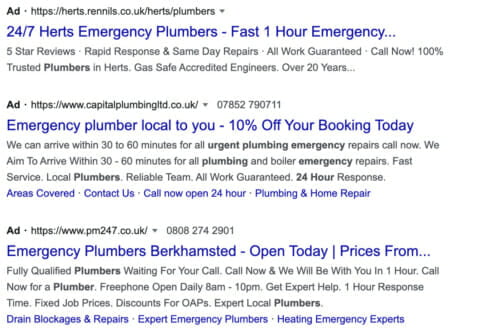
If someone clicked on your ad, you know their search intent, they are ready to hire you. It's highly valuable, quality traffic.
With this type of ad platform, it's Pay Per Click (PPC), so you only pay for the advert when someone clicks on it.
This might sound great, and it can be. But in a competitive niche, for example, personal injury law, you might be paying $75 and upwards to be in with a chance of getting in the top 3 ads. On the upside, you do know that the increase website traffic is high-value traffic.
Niche Advertising - Going where your ideal clients are
If you know where your target audience goes when they need news and information about their industry, then you can use that knowledge to your advantage.
If, for example, your ideal client is a family lawyer, they have the usual social networking accounts but when they are interested in keeping up to date with what's happening in family law, they listen to "The Family Law" podcast.
You will want to look at contacting the podcast owner and discuss the advertising opportunities they have available. They have your target market, you want to get to them. This is perfect.
Obviously, podcasts aren't the only option, you can look at family law industry news websites and industry blogs.
Here's an example, you'll see this page is sponsored - a great advertising opportunity for "The University of Law".
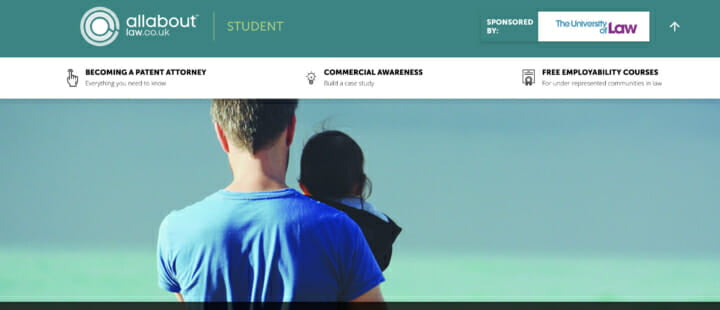
Use Google to find more relevant online communities. Talk to family lawyers and ask them what they read/watch/listen to.
Niche advertising will drive high-quality traffic to your website. This is an effective tactic to get a high-value increase website traffic.
Content Marketing
Content marketing has its fingers in almost every pie of digital marketing. You need content for email, copy for Ads, you need lead magnets for email list building, you need content for your sale pages, landing pages, and the list doesn't stop.
So how do we use content marketing to generate traffic? And how do we use it to increase website traffic?
In this section, I'm going to focus on using content creation for authority building (which will in turn generate organic traffic).
Building Authority
So how does authority building work and why will it help drive traffic to your website?
Firstly, having high-quality, relevant content on your website means that the user experience is enhanced.
If a prospect on your site finds everything they need whilst researching you, your product, services, or just finding out information about the topic, then they will see you as an authority.
This increases trust and once you have someone that trusts you, you're a good way towards a sale.
So being an authority helps with conversions, from visitor to email subscriber, or from subscriber to customer.
Secondly, search engines, Google, in particular, places importance on how authoritative a website is on the topics it covers.
If very similar pieces of content were on 2 websites, there's a significant chance that the version on the most authoritative site would rank more highly in the search engine results pages (SERPS).
The higher you rank on the search results, the better chance you'll get clicked by the searcher. Increasing authority through relevant content should increase your organic traffic from the search engines.
The Blog Post
Now I've shown the connection between authority and more traffic, we'll look at content.
We need to create content (the right content, long-form content, high value content, will drive more traffic).
The content needs to be something our ideal client is interested in. It needs to be relevant content.
Ideally, the subject or topic attracts visitors and has a reasonable search volume. There's little point in spending time/money on content that nobody would be looking for!
Keyword Research (from 30,000 feet)
This is where keyword research comes to the rescue.
You select a topic that you think is relevant to your ideal client and is related to your niche/business.
Next, you make a list of words and phrases that you think your ideal clients would type into a search engine to find out about that topic.
Long tail keyword research (no animals required)
Don't just have short phrases, like 'Plumber', but also include long-tail keywords such as 'emergency plumber Jacksonville or/and 'help with dripping tap'.
At this stage, you might want to use google to help come up with some ideas. If you type your keyword idea into the search box, Google will offer autocompletion of related searches.
You can decide which of these related searches are relevant to your products/services.
Once you have your list of words and phrases (keywords and long tail keywords), you'll want to get a tool to help you understand how many people look for those words in google and to see relative keyword difficulty, you don't want to try and rank for ultra-difficult keywords, that could take an enormous effort (cost).
Keyword Planner (free and direct from Google)
There are some free tools that can help with this task. Google again rides to the rescue providing Keyword Planner as part of the Google Ads platform.
You give it a list of keywords and long tail keywords and it returns you the search volumes for each. Additionally, it will look for related keywords and display their search volumes too!
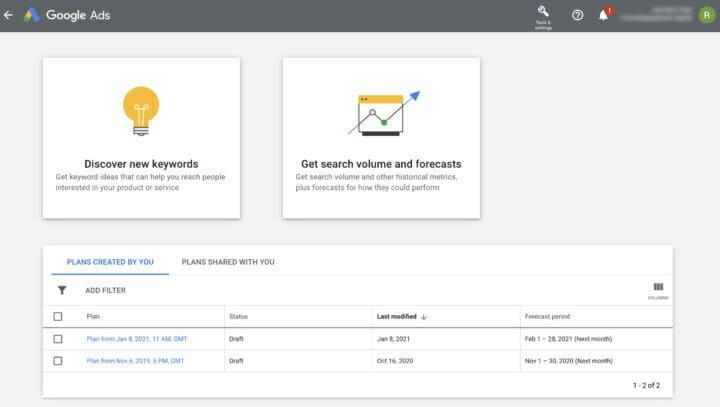
You use this information to know if the proposed topic is worth investing time/money in. You can also decide the combination of words and phrases that will bring the highest level of traffic.
So you go through this process for related topics to generate a list of topically relevant articles that will support one another. You want to be careful to avoid overlap, you don't want articles to compete for the same words and phrases.
Once you've finalized your keyword research, got your list of articles with their keywords, and long tail keywords you're ready to start the content creation process.
The Blog Post
On many business websites, authority content is presented to their audience in blog articles.
Blog articles allow comments from readers, they allow easy internal link building, they don't usually require much design, they can be easily updated, and using an RSS feed they can be quickly distributed to social media channels.
Don't forget to promote blog posts. As each new piece of content is completed (and optimized for search engines and internal links placed) you can drive traffic to your website by emailing your subscribers telling them about your new post. You can get a message to Twitter, a post to Facebook, etc
Over time, the search engine bots will crawl your site (don't worry, it's not painful). They examine your site looking for new and changed content which is then indexed so it can be found in the search engine results pages, which means that you can get organic search traffic.
As your collection of topically related content grows, blog post by blog post, so too will your site's authority and along with more authority comes more traffic or website visitors.
Get an SEO copywriter - Create Content
Producing content that's high in quality on a regular basis is hard work to do yourself but there's always the option of engaging a talented copywriter to ease the workload (there are heaps of experienced copywriters just waiting to author your blog content).
You'll need to create a content brief for each blog post and you'll want to review and ensure each piece is to a high standard.
You'll want an SEO copywriter, they understand the importance of keywords, structure, and the use of headings. They should also help with a title and meta description.
Each should be a comprehensive blog post, covering every angle of a topic, reviewing the available options presenting pros and cons, etc and it should be written to satisfy the search intent of the keywords.
There's an invaluable tool for creating SEO content and for creating briefs for copywriters, Surfer SEO.
With quality blog content, your task toincrease website traffic will be easier! (People (and google) like quality content).

Search Engine Optimization
Earlier we looked briefly at on-page SEO, that's all the SEO tasks on your website. Here we will look at off-page SEO.
Off-page SEO deals with the SEO outside your website. How it relates and is seen by others.
On-page SEO can have a significant role in driving traffic to your website, but off-page SEO can significantly impact your position in SERPS (search results) and therefore it's at least as important when bringing traffic to your website.
Link Building - How, why and where
Links from one website to another are like votes. And the more votes your site has the higher its authority. This is a vast simplification, but it will do for now.
If you have a site with zero links to it (zero backlinks), then it will not perform well when it comes to driving traffic to your site.
If you want to increase traffic to your website, you'll need more backlinks from relevant websites.
So where do you find these backlinks? How do you get them? How many do you need to get more traffic? Are all backlinks created equal?
Guest Posting
There are billions of websites on the internet. Webmasters need to post new content regularly, and they're happy to accept articles from third parties in order to do so.
These 3rd party posts are called guest posts or guest blogs.
The Webmaster gets free, new content, but what does the guest poster get out of the deal?
Valuable content needs links to supporting sources, links to articles that explain a concept or provide evidence.
In addition to such links, the author is usually allowed to add a link to their own site. A backlink.
That's the concept, a link in exchange for content, but how does this work in practice?
Prospecting for a Post
You need to find sites that might accept guest posts. A list of prospect sites.
A good way to find an initial list is to use google, you'll need a search something like this:
"write for us" +NicheYouAreIn

The search results will be full of interesting opportunities that you'll need to investigate.

Build a google sheet with a couple of columns, Website URL, and Email.
Fill the sheet with prospects.
Guest Blogging Outreach
You have your prospecting Google Sheet. Next, you need to follow the instructions each site has on their Write For Us page.
Some of your prospects will provide information on the subjects you should consider writing about, here's one set from a family law site:
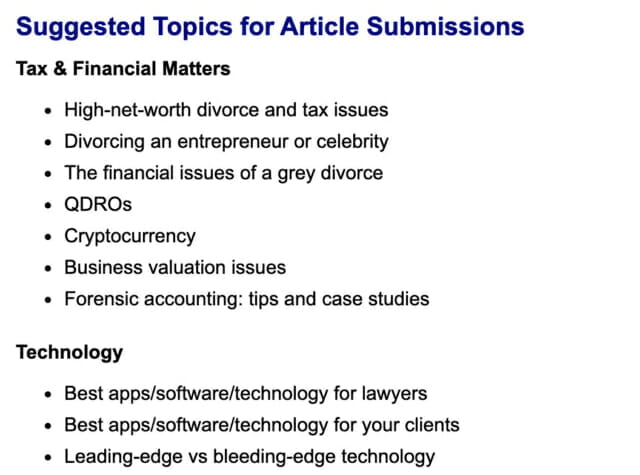
You'll either need to send them an email or fill out a form pitching an idea.
Keep your communications short and to the point.
Hopefully, you'll hear back from the webmaster and they will offer you an opportunity to guest post on their site.
Remember, the more you guest post the more your authority will increase and the more traffic you will get on your site.
The Guest Blog
So the Webmaster gives you the opportunity to get started in guest blogging. Now, what do you do?
Make sure you pay attention to any guest post guidelines that were provided.
Often there will be a minimum word count for the blog post, there may be a maximum number of authority links you can include.
Sometimes the Webmaster will supply images and other times you'll need to supply images.
Just make sure you follow their guest posting guide to the letter.

Guest blogging might seem like a lot of work, and it is. Prospecting, outreaching, producing the guest post, following instructions for each site, it's hard.
Remember you need the links. Your competitors have links and you need backlinks too. Guest blogging doesn't require the exchange of money (although some webmasters may charge), and writing a 1000 word guest blog doesn't have to take a long time.
More guest posts will lead to more referral traffic.
More backlinks will lead to more authority, and that will lead to more website traffic.
Social Media Marketing
Using social media can be a very effective method to increase website traffic.
The Viral Post
We've all heard stories about how social media posts can go viral, imagine if one such post directs readers to a website, that site could get more traffic than it could deal with!
But this is not typical. Most social media posts don't go viral. Many aren't even read. People scroll and scroll only stopping to see something that really stands out and breaks the boring pattern.

So how do you go about using social media to increase website traffic?
The Reality of Viral Posts
Relying on regular viral posts isn't a good idea, for most users of social media, they don't come along with reliability and predictability.
You can't plan for them and you shouldn't base your marketing strategy on them.
So what do you do?
Social Media Marketing Strategy
There are many social media platforms available today. They come and they go, what was popular 5 years ago may have vanished.

Myspace was once a popular social media platform, but now ... any ideas where it is?
5 years from now, the social media space may be completely different, who knows who the main players will be.
Because of the volatility in the social media space, it's worth having an approach that you can use that is, in general independent of the platform. An overall strategy that works regardless of the platform.
When you have a strategy, you can then implement a system, based on that strategy, that is specific to each platform.
The more channels you are active in, the more website traffic you can generate.
Understanding the platforms Goal
Gain an understanding of the platform's goal. What does it deliver to its users and why does that matter?. What is the user experience? Who are the intended users? How does their platform support its users in achieving the goal?
Once you understand the goal of the social media platform and the systems/mechanism that have been provided for the platform's users you have a choice.
You can work out how to best use the platform yourself, this might include a lot of trial and error, testing, and re-testing or you can learn from the experts that are already there.
Find the experts and learn from them
You'll need to search for people on the social media platform who are in your niche or who have a following made up of your ideal clients. Join their communities, follow and connect with them ... become one fo their social media followers.
Watching what's posted and how their other followers react and engage will give you an insight into what works on the platform. You'll soon learn who knows how to get the best out of the platform. You need to learn their tactics so that you can emulate what they are doing. You can save yourself much of the trial and error and resulting frustrations by learning the right way to use a platform directly from an expert.
Understand what, when and how to publish
Each social media site has its own publishing tools and channels. You'll need to decide how to map the content you already create into those publishing channels.
Update your content publishing schedule to include posting/publishing to the new social networks.
Remember your goal, you want to push people from the platform to funnels on your website so that you can convert them into "traffic you own" - an email list subscriber.
Through social media sites you'll be able to increase brand awareness and drive more traffic to your website.
Email Marketing
Many business owners don't believe that email marketing is effective. This is untrue.
Email marketing is highly effective and delivers remarkable returns on investment (it can drive traffic to your website extremely effectively).

The purpose of email marketing is to move a prospect/customer from one stage of the customer journey to the next. (I guess you'll need to understand and have your customer journey mapped out for that to make sense).
For example, you can use email to move a subscriber to the next stage, which is often a conversion to a customer! Yeah, you made a sale.
You will probably use email to help a new customer get the most value from their purchase. You might direct them to an instructional video or supplementary information.
With each part of your email marketing strategy, you can drive direct traffic to your website by the inclusion of a call to action. This website traffic is under your control since you can select the target URL.
This web traffic is extremely valuable. It can be visitors ready to convert to customers. (Yes, more customers for you). Or it could be someone looking to upgrade or buy an additional product.
Let's look at all the email opportunities, each of which, can be used to drive targeted traffic to your website.
Email Types
Within our email marketing mix are several different types of emails. We have 3 types:
- Transactional
- Relational
- Promotional
Transactional Email
You would use transactional emails for a variety of purposes such as:
- Account creation
- Shipping notifications
- Confirmation of an order
- Purchase receipts
- Conformation of a return
- Support ticket notifications
- Lost password management
- Unsubscribe confirmation
Some of these may naturally have a link back to your site, but you will want to be creative in ensuring you include links back to new products, promotions, related articles etc.
Open rates on transactional emails are high, and so you investing time in the details of their content is more than worthwhile. Transactional emails are an effective way to drive traffic to key pages on your site.
Relational Email
This category covers:
- Welcome emails to new subscribers
- Notification of new articles, blog posts and helpful resources
- Lead magnet delivery
- Announcements of competitions
- Confirmation of a Webinar seat
- Requests for reviews or surveys
- Referral requests
- Notifications of Social Media updates
Again, we have lots of opportunities to drive website traffic right where we want it.
Promotional Email
Our promotional emails are used to sell products and services, we have:
- New products launches
- Announcements of upcoming Sales
- New lead magnets
- Sales funnel email sequences
- Trial Offers
- Announcements of Webinars
- Upgrade & add-on offers
- Announcements of Events
Even more emails that we can utilize in our quest for more website traffic.
With so many email opportunities, you'll need to carefully plan what's getting sent and when.
You don't want subscribers to be overwhelmed by the number of emails they receive from you on any one day.
Create an email marketing calendar for your promotional content and plan when each campaign will start and end.
With the high value of the website traffic, you can drive with email, this planning is very worthwhile, you need to keep your subscribers happy.
Email List Building
Email lists are extremely valuable and so every marketing strategy should include list building to ensure the growth of the business.
Ensure your website and other marketing materials are set up for list building and remember that to increase website traffic, just take advantage of your email list and send a new campaign.
Conclusion
We have covered many ways to generate web traffic, and you can see, it takes effort and it can cost money depending upon the approach you decide to take.
The quest for website traffic shouldn't be an end in itself, the true goal is more customers, to grow a thriving business.
With the conclusion done, it's time for some very actionable tactics that you can put into practice without delay.
Actionable Tactics
Useful Content
Talk to your support department and sales team, they have their finger on the pulse, they deal with your customers 1:1 on a regular basis. Find out what your clients and prospects most asked questions are.
Take the feedback, and list out How-to articles to answer those questions. Write a content brief to go along with the title.
Add each of these to your content marketing plan.
If you need more ideas than those you got from your internal teams, install the SEO Minion Chrome extension. After you've installed it, take each of the questions you've already got, in turn, to the search box and hit return.
You'll get the usual google results and an additional box in the right-hand column.
The SEO minion tool will have given you some additional insights and you'll have a great source of People Also Asked questions.

In the SEO Minion box there will be a couple of pull-down menus. In the first, select Download. In the next, pick PAA Suggestions (50 clicks or however many you want).
You'll get lots of new questions, you could work through them with your customer-facing teams and decide which are worth answering with further how-to articles.
If you want to get feedback from SEO tools to indicate search volumes and keyword difficulty, take your article titles and place them into ahrefs bulk keyword analysis tool or into the Google Ads Keyword Planner.
Repurpose Content
This is where you take content from one channel or medium and utilize it on another channel or medium. Of course, this investment in time and money is best spent on your most popular content first.
For example, if you have a popular video on YouTube that attracts a good number of views, then take the video and have it transcribed. Whilst you're at it, also make an audio version.
Use the audio version as the basis for a podcast (as is or edit it).
With the transcript, you can create blog posts or you can build a lead magnet.
As you can see, you are maximizing the value of each piece of content that you already have and you're building your authority on more channels.
Repurposing Ideas
Here are just a few of the ways to repurpose content:
- Images ->Pinterest Board
- Webinars -> Videos
- Quora Q&A -> Blog Posts
- Blog Posts ->Lead Magnet
- Interviews -> Blog posts or Ebooks
- Slideshow -> Infographics
- Statistics -> Twitter threads
- Slideshow -> Blog posts
- Blog Posts -> Podcasts
Content Upgrades for Lead Generation
The concept of exchanging a lead magnet (something of value to your ideal client, like a checklist or cheat sheet) for their contact details has been long understood.
A visitor arrives at your website, and after 10 seconds or so, a pop-up appears on their screen offering the Lead Magnet deal.
The use of pop-ups can be, from the user experience point of view, a little intrusive.
These pop-ups do convert but there's a newer, less jarring way to do it - the content upgrade.
You have an article that is related to your lead magnet, it's not as thorough or detailed, but it whets the readers' appetite. Partway through the article and again at the end, you have a highlighted box instead of the pop-up - it can contain the same deal, with the same words.
If you need some inspiration, here's a recommended read: lead magnet ideas.
Get your content out on an Aggregator site
A content aggregator is a website that does not create its own content. Instead, they extract and collect content from other sites to offer it in one place.
An aggregator benefits both the user and publisher, as readers can find a variety of articles in one place while publishers get their stories seen by people interested in them.
Here is a list of content aggregators where you can submit your content
Invite Others to Guest Blog on Your Site
In this article, we have already discussed the use of Guest Blogging to generate backlinks. But, you're a Webmaster in need of high-quality content.
Don’t think you can only write content for other sites.
Invite other people to submit articles to your blog. Keep in mind that the quality of their submissions will reflect on you and your business.
Guest blogging is a great way to gain new content for your website, and the guest blogger will likely promote the article, which will bring more traffic to your blog.
It's a win-win.
Put this one towards the top of your list for increasing website traffic.
Get on Quora - Answer Questions
What is Quora? Quora is an online Q&A site where readers post and answer questions.
As you can probably imagine, Quora can drive traffic to your website.
Create an account if you don't already have one.
Next, you'll want to find the right questions to answer.
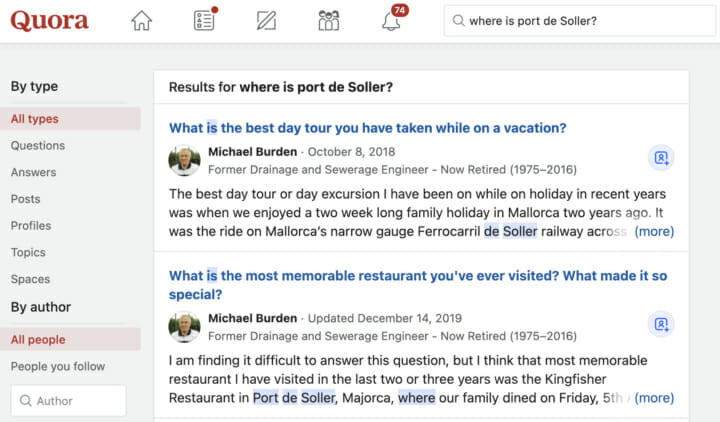
Do this by entering keywords into the Quora search box, it will return a list of related questions.
Select something that's of interest in the returned results and you can then add your answer to the conversation.
On Quora, you want to be seen as an authority, you'll want to give complete, detailed answers that look at every angle of the question. If you have a related article on your website, then you should add a link to it.
This is how you drive traffic from Quora back to your site. While working on this activity, you might also come up with ideas for more content for your website - create a title and brief - add it to your content plan.
Social Share Buttons - Install them on your site
When you are spending time and money creating valuable, high-quality content for your website you want to make it easy for your readers to share that content with their friends, family, and colleagues.
All those shares will lead to more traffic and hopefully to more customers.

Write irresistible meta descriptions
A meta description typically outlines what a page's content entails. Search engines like Google often display these on the results pages.

In the search result above, the meta description is the 2 lines following the page title (which is in blue and underlined)
A well-written page title can catch the interest of internet browsers, but an alluring and interesting meta description will also increase clicks to your website.
Google states: “A meta description tag should generally inform and interest users with a short, relevant summary of what a particular page is about. They are like a pitch that convinces the user that the page is exactly what they're looking for.”
If your meta description isn’t interesting, or if it doesn’t offer a compelling reason to click on the link for more information, you will not get as much traffic. This could affect your organic search ranking.
Metadata descriptions are often shortened and truncated to fit them onto smaller screens.
A good meta description:
- Summarize the page content
- Use a maximum of 150 characters
- Create a unique description for each page
- Make the description intriguing and click worthy.
- Include your keyword in the description
Your Referral Program
If you don't have one, you need one!
Reward your readers for spreading the good word on your behalf.
With an email referral program, you can tap into the collective promotional power of your email list to increase subscriptions and of course, they drive traffic.
Blog commenting
You could also use blog comments as a way to increase traffic to your site.
Let's look at how you can use comments to get more traffic for your site.
Begin by finding out sites posting content related to your niche.
Buzzsumo is a tool that will help you find sites and content where your relevant comments are appreciated.
One way to find industry sites similar to the ones you’re already visiting is with a plugin called ‘Similar Sites.’
It’s important to analyze the traffic, site authority, social media influence, and page view estimates. For example does the content get shared? Do people relate to the author?
Maintaining a blog commenting strategy can be time-consuming, so keep this in mind.
For the highest impact, you'll want to be one of the first people to comment.
It’s worth mentioning that comments left on your industry's websites are going to bring you better results than those on blogs that don't relate to your industry.
When leaving a comment, make sure that you are adding something beneficial to the discussion.
If someone posts a question, answer it as fully and thoughtfully as possible.
This will showcase your authority and expertise and other readers may be encouraged to find out more about you by clicking on your name which will take them to your website.
"So long and thanks for all the fish" - Douglas Adams, HHGTTG
If you want your company to grow, gain clients and succeed, and if you want this through an automated marketing system, then get in touch to see how Graphene Digital can help you.
